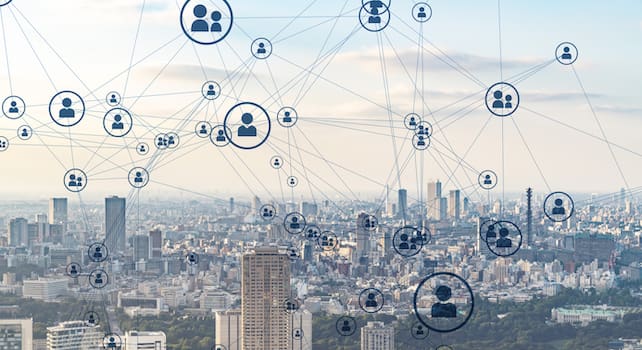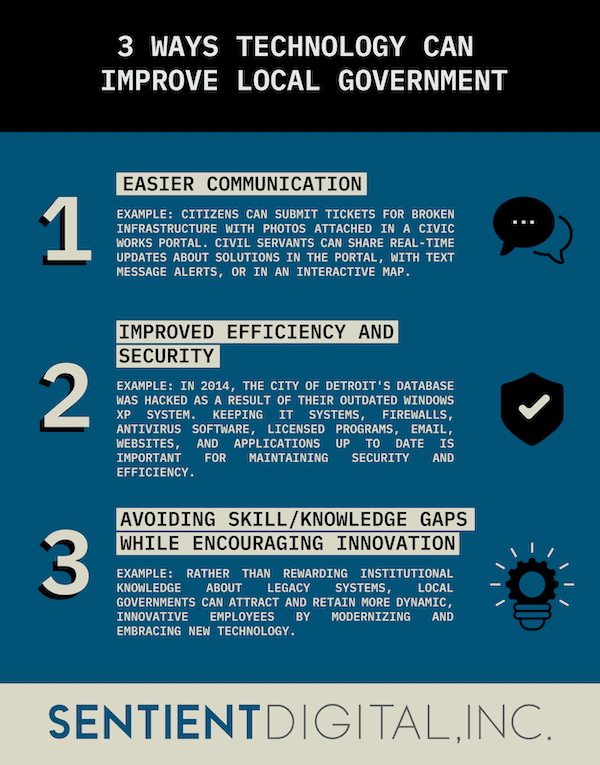Advances in technology are playing an increasingly outsized role in democracy, from social media providing direct connections between citizens and elected officials, to purpose-built apps designed for reporting outages and civic disruption. But many stakeholders are still asking, “Why is technology so important in local government?”
In recent years, the integration of artificial intelligence into various sectors has revolutionized processes, efficiency, and decision-making. Local governments, entrusted with the responsibility of serving their communities, are increasingly turning to AI to optimize their operations. From predicting demand for waste management and optimizing public transportation routes to revolutionizing healthcare services and bolstering climate control efforts, AI is at the forefront of driving innovation and efficiency in government and societal systems. When technology is successfully leveraged by local governments, it can also facilitate grass roots applications and communication, improve efficiencies and security, and avoid skill and knowledge gaps while encouraging innovation.
As AI continues to evolve and expand its applications, its role in facilitating easier access to essential services, promoting transparency, and fostering collaboration between governments, citizens, and other stakeholders will become increasingly significant in building a more resilient and sustainable future. Keep reading to learn more about each of these benefits and why technology is so important in local government today.
WHY IS TECHNOLOGY SO IMPORTANT IN LOCAL GOVERNMENT?
Disruptors and startups have revolutionized systems and services in the private sector. Consumers can find slick and user-friendly applications for accessing large pools of information, locating and comparing products, and signing up to services and payment systems. All too often, local government has been somewhat left behind.
For example, ordering groceries and consumer goods, booking flights and hotels, and identifying and comparing restaurants in unfamiliar cities is a frictionless, speedy process now. Meanwhile, consider the processes for basic and essential government interactions like paying for parking, filing taxes, and reporting burst water mains. These typically remain disorganized, inefficient tasks that involve a patchwork of agencies and departments with ambiguous portfolios.
The question “why is technology so important in local government?” is really about closing the gap in efficiency between civic systems and their for-profit equivalents. Local government is being left behind, creating frustrations for stakeholders (including civil servants, third-party contractors, elected officials, and citizens alike) and leaving individuals with outdated systems.
As well as resulting in needlessly lengthy and costly processes and suboptimal user experience, local government agencies which have failed to embrace contemporary technology are at risk of hacking and other types of data breaches. This makes technology even more important in local governments looking to maintain information assurance and avoid data leaks.
5 REASONS WHY TECHNOLOGY IS SO IMPORTANT IN LOCAL GOVERNMENT
1. GRASS ROOTS APPLICATIONS AND COMMUNICATION
With an entity the size of a mid-level American city, there is the requirement for a vast amount of communications between its citizens and the administrators and officials tasked with running the city. Historically, this has become bogged down in bureaucracy, failing to deliver efficiently for various stakeholders.
When a citizen becomes aware of an instance of infrastructure failure, such as a series of broken streetlights, the process to have them fixed has often been lengthy and overly complex. The citizen might discuss the issue in a meeting, like a neighborhood watch, and then call the city. They would probably be passed between different departments with little accountability or ownership of the problem.
Once the correct department was notified, it would then be a question of either notifying the correct facilities team or private contractor. It isn’t uncommon for a request or complaint to “bounce around” the bureaucratic system and the citizen to feel that their need is low-priority and unheard.
It is essential that local governments embrace technology to revolutionize this patchwork of processes. In the contemporary city, a citizen could take a photograph of the failed lighting with their smartphone and share it on a Facebook neighborhood page or the Nextdoor app. If their city has the right technology, the citizen could upload their photo directly to an easily navigable civic works portal, which could create a ticket for the responsible department.
The same citizen could share the image on the city’s social media accounts as well, interacting with the city directly and looping in the media to create accountability. Technology is important in local government for facilitating this type of communication, enabling civil servants to share real-time updates with citizens and make information about solutions available via a portal, direct text messages, or an interactive map.
AI holds the potential to revolutionize citizen engagement in government, fostering a more responsive, inclusive, and transparent governance framework. Governments can enhance communication channels, personalize services, and empower citizens to participate actively in decision-making processes.
In addition to social media, AI-powered chatbots and virtual assistants serve as accessible and user-friendly platforms for citizens to interact with government agencies and access information and services. Whether it’s providing answers to frequently asked questions, assisting with form submissions, or guiding citizens through bureaucratic processes, chatbots offer real-time assistance, reducing wait times and improving overall satisfaction.
Moreover, AI enables governments to personalize citizen services and recommendations based on individual preferences and behaviors. By analyzing data from various sources, including past interactions and demographic information, AI algorithms can tailor information and services to meet the unique needs and interests of each citizen.
AI also enables governments to identify trends, sentiments, and emerging topics of interest among citizens. This real-time insight enables governments to anticipate public concerns, address misinformation, and tailor communication strategies to resonate with the public.
By leveraging technology, governments can build stronger connections with citizens, while also promoting transparency and accountability.
2. EFFICIENCIES AND SECURITY
Legacy System Inefficiencies in Local Government
Increasingly, civic processes on all levels are becoming antiquated, at the expense of user efficiency, value, and security. There is abundant anecdotal evidence of dated and lengthy legacy systems existing in the public sector.
There are forms and applications which need to be downloaded and printed before being mailed back, face-to-face appointments which need to be booked over the phone during regular working hours, and fishing licenses which are still issued on paper and in person. By contrast, countless for-profit businesses have embraced real-time signups, appointment bookings, and application submissions via Facebook, Zoom calls, and e-verification.

With local governments struggling under legacy systems, often officials and agencies end up using a patchwork of applications, with expensive bespoke workarounds. Data is not readily accessible, and end users are required to navigate byzantine processes.
From a front-end perspective, this means citizens having to create multiple online accounts to make payments, for instance, and holding numerous accounts for government services. A user may submit information and payment to their local government across multiple platforms for health, education, housing, tax, refuse collection, and law enforcement, for instance. This is not only frustrating for users, but also costly in terms of staff processing.
Legacy System Security Issues in Local Government
In addition to the inherent inefficiencies when a government operates using a patchwork of legacy systems as opposed to a cloud-based integrated system, there are additional security risks. Many government departments at all levels store sensitive citizen information on in-house mainframes which haven’t been updated for years.
In 2014, the City of Detroit was held to ransom after malicious agents accessed its database. It later emerged that the hack was only possible due to the city’s outdated Windows XP system, raising nationwide concerns about cybersecurity in local government.
Far from an isolated attack, the Detroit ransomware crisis has been repeated in data breaches throughout the country. From law enforcement records to medical information, financial data, and more, civically held computer files are a treasure trove to malicious actors. Keeping them secure must be an absolute priority and is a major factor in why technology is so important in local government agencies.
Modernizing Technology in Local Government
Securely migrating a local government’s various legacy systems to a state-of-the-art and future state ready unified system is not an easy task, but it is well worth it in terms of efficiency and security.
Creating web pages and applications which are easily navigated and allow citizens to access information, request services, sign up for alerts, and pay bills must be a priority for local governments. For a contemporary democracy to function effectively, technology has to be rolled out securely and expertly. This includes everything from apps which allow households to report power outages in their neighborhoods, to websites which securely stream city hall hearings.

Cyberattacks are rampant, and when it comes to technology strategies, advice is centered on modernizing:
- An up-to-date system is a more secure one, while a dated system is liable to attacks and failure.
- Fastidiously update firewalls, antivirus software, and licensed programs.
- Secure external emails and keep IT infrastructure secure.
- Wherever possible, make use of multi-factor authentication.
- Build a quality culture where the regular training of employees on cybersecurity is integral, rather than an optional add-on.
- If budgets don’t allow for building IT infrastructure to purpose from the ground up, then use trusted technology partners to update legacy systems.
Leveraging AI for Fraud Detection
By analyzing financial transactions, AI-powered systems can flag potential irregularities, such as unexpected fluctuations in spending, unusual purchasing behaviors, or irregularities in payment processing. By analyzing historical data and identifying risk factors, AI algorithms can forecast potential fraud.
Because AI integrates data from multiple sources, government agencies can uncover complex fraud schemes that span across different sectors. This collaborative approach enables agencies to pool resources, share insights, and coordinate efforts to detect and prosecute more efficiently.
Law Enforcement and AI for Public Security
For better or worse, law enforcement is increasingly making use of AI. The potential here is great, but so are its ethical implications.
AI can potentially identify, deter, and combat criminal activities. Law enforcement can analyze vast amounts of data, identify patterns, and predict potential criminal behavior, thereby enhancing public safety and security.
By analyzing historical crime data and demographic information, AI algorithms can identify high-risk areas and predict where crimes are likely to occur. In an ideal world, this proactive approach enables law enforcement agencies to allocate resources more effectively, deploy patrols strategically, and deter criminal activities before they happen.
AI-powered video surveillance systems enhance situational awareness and enable real-time monitoring of public spaces. By analyzing live video feeds, AI algorithms can potentially detect suspicious behaviors, identify individuals of interest, and alert law enforcement personnel to possible security threats. This proactive surveillance could help prevent crimes such as theft, vandalism, and terrorism, while also facilitating faster response times to incidents as they unfold.
In addition, AI enables law enforcement agencies to leverage social media to gather information and track criminal activities. By monitoring social media platforms and online forums, AI algorithms can identify potential threats, track the spread of illicit activities, and gather intelligence on criminal networks. In theory, this digital intelligence gathering enhances law enforcement’s ability to investigate crimes and disrupt criminal operations.
AI-powered forensic technologies can also enhance the analysis of evidence to support criminal investigations. From facial recognition and fingerprint matching to voice analysis and DNA profiling, AI algorithms automate and accelerate identifying suspects and linking them to crimes. This advanced forensic analysis could potentially help law enforcement agencies solve cases more efficiently.
As previously stated, these benefits exist in theory, but they are not always so effective in practice due to the biases that can affect artificial intelligence. To start, AI learns from historical data, which can be biased. This can lead the AI to replicate these biases, sometimes on an even larger scale. Racially biased arrest data, for example, can train AI to identify or target racial minorities at a disproportionate rate. There is also the risk of sampling bias if AI is trained on too narrow a data set. If data from urban cities are used to train AI, its efficacy may be limited in rural towns. There is also research to suggest biases from AI-powered surveillance technologies. Facial recognition technologies, for instance, may be more likely to misidentify certain racial groups.
Bias can also be introduced in the creation of algorithms and the set of rules or assumptions they operate on. Areas that have been overpoliced in the past could be identified as more likely to require policing, even if actual crime rates do not support this finding. If left unchecked, this would create a feedback loop of AI identifying the same areas for additional policing, leading to more actual policing, leading the AI to continue to flag those areas.
3. AVOIDING SKILL AND KNOWLEDGE GAPS WHILE EMBRACING INNOVATION
Dated systems and legacy processes quickly come to characterize the culture of an organization, from a fast-moving startup to a regional civic office. In a business or government agency which has failed to modernize its technology, staff will become reliant on insecure workarounds and applications which are added on in an ad hoc fashion. A culture begins to emerge in which reactive fixes are used, rather than proactive investment in future state systems architecture.
For any organization looking to thrive in the current IT environment, this is disastrous. The department or organization will become sluggish and torpid, staffed with people who possess institutional knowledge about legacy systems, rather than attracting and retaining dynamic and innovative employees. It will become increasingly difficult to connect data from different areas, and as a result, efficiency and user experience will suffer.
In contrast, the local government agency which embraces technology is able to transform into a slick and user-orientated workplace, where decisions are made in the pursuit of efficiency and user experience. Technology transforms every aspect of local government, creating a 360° flow of information and communications.

Stakeholders can report failures and requirements back to the government agency responsible, and the agency can solicit feedback from the users. Payment systems and requests for information are handled frictionlessly. Departments are able to build up banks of usable data which they can process easily, making informed decisions which serve the people.
One of the primary ways AI can benefit local governments is through data-driven decision-making. Utilizing AI algorithms allows local governments to analyze vast amounts of data collected from various sources. This is useful for obtaining administrative records, public opinion, and more. This enables policymakers to make quicker decisions on various issues, from urban planning and transportation management to public health initiatives and emergency response strategies.
From coordinating refuse collection to paying fines, gaining real-time information about school closures after weather events to applying for jobs via a centralized portal with a single account, the entire experience of interacting with the government becomes convenient, straightforward, and mutually methodical with the proper technology solutions.
4. RESOURCE ALLOCATION
By analyzing historical data and current trends, AI algorithms can forecast demand for services such as waste management and public transportation. This enables authorities to allocate resources more efficiently.
In waste management, AI plays a crucial role in optimizing collection routes and schedules. By analyzing data on waste generation rates, population density, and traffic patterns, AI algorithms can identify the most efficient routes for waste collection vehicles, allowing authorities to prioritize collection in areas with the highest demand.
Similarly, by analyzing data on passenger demand, traffic congestion, and travel patterns, AI algorithms can predict peak travel times and optimize bus and train schedules accordingly. This proactive approach ensures that transportation services are aligned with passenger needs, reducing wait times, overcrowding, and delays.
If governments use AI for resource allocation in addition to facilitating communication between citizens and civil servants, all the better. In this case, the government will be able to better predict its citizens’ needs using AI, and if its forecasting ever falls short, citizens can easily report their issues.
AI algorithms can also filter data to analyze patient data, predict disease outbreaks, identify trends, and personalize treatment plans. This technology is critical for preventing epidemics and pandemics.
In fact, at SDi, we produced Conjecture Covid, a cluster analysis R&D Project, to monitor and forecast the spread of COVID-19 early in the pandemic. Created for those who work in public health, its primary objective was to assist in containing and managing the COVID-19 outbreak and its spread. Conjecture Covid is a system of mathematical models, using the concept of community structure in complex networks as the basis of predicting COVID-19’s spread and defining the network using connections found on social media between users. In addition to using data from social media, Conjecture Covid uses a series of connected simulations that emulate the disease’s spread in an artificial environment.
5. CLIMATE MANAGEMENT
AI technologies are revolutionizing climate control efforts across various sectors. One of the primary applications of AI in climate control is energy management. AI-powered systems can analyze real-time data to optimize energy consumption and reduce carbon emissions. By predicting energy demand patterns, identifying inefficiencies, and automating energy-intensive processes, AI enables governments to minimize their environmental footprint while maximizing efficiency and cost savings.
Moreover, AI plays a crucial role in renewable energy integration. AI algorithms can forecast renewable energy generation from sources such as solar and wind, enabling municipal operators to balance supply and demand more effectively. Additionally, AI-powered predictive maintenance systems can optimize the performance of renewable energy infrastructure, such as wind turbines and solar panels, by predicting potential equipment failure and enhancing their reliability.
AI is revolutionizing weather forecasting and extreme weather prediction. AI-powered weather prediction models leverage machine learning algorithms to analyze historical weather data, atmospheric conditions, and oceanic patterns, resulting in more accurate and timely weather forecasts. These advanced forecasting capabilities enable government authorities to issue early warnings for extreme weather events such as hurricanes, floods, and heatwaves, thereby minimizing risk.
AI technologies are also being used to enhance climate resilience and adaptation efforts in vulnerable communities. By analyzing socioeconomic data, geographical features, and climate risk maps, AI algorithms can identify areas most susceptible to climate-related hazards and prioritize adaptation measures such as flood defenses, drought-resistant crops, and resilient infrastructure. Additionally, AI-powered early warning systems and decision support tools enable communities to prepare for and respond to climate-related disasters more effectively.
Recently, central banks began utilizing AI technology to understand climate-related risks and promote financial resilience. In March of 2024, the Bank for International Settlements, the Bank of Spain, Germany’s Bundesbank, and the European Central Bank reported using AI to review company disclosures on carbon emissions, green bond issuance, and net-zero commitments. Because traditional methods of risk assessment fall short of capturing the complexity of climate-related events, AI is being used to provide more accurate information that shapes these policies.
WHY IS TECHNOLOGY SO IMPORTANT IN LOCAL GOVERNMENT? ASK OUR EXPERTS
Building modern, secure technology for your organization can be challenging. There are risks that key stakeholders get left behind, that costs or deadlines overrun, or that user data isn’t safeguarded during the migration process. It is critical to find a trusted, experienced provider with a history of successfully serving government clients.
Sentient Digital is a veteran-owned and operated business with offices in Louisiana, Virginia, Maryland, and Pennsylvania, serving clients around the globe. We provide government and commercial clients with the technology solutions they need in order to meet their objectives. With a flexible, agile mindset and experience across numerous delivery models, we apply a variety of technological solutions, management threads, and industry best practices to deliver effective, efficient digital solutions.
According to one of our clients, a U.S. Navy Expeditionary Communications Program Manager, “Without hesitation, Sentient Digital completed redirected tasks within one day while maintaining the integrity of the image, equipment, related documentation, and configurations which was a benefit to the Government. The overall quality of work was exceptional.”
Whether you’re looking to update your systems in order to keep them secure from malicious attacks, create a future state ready and efficient multi-department data system, or migrate your agency’s existing patchwork of dated processes into a unified and slick cloud-based upgrade, SDi can help. Contact us today to learn more about our technology solutions for your government agency.





